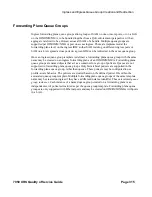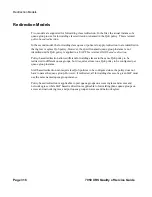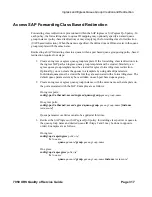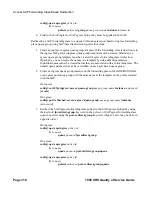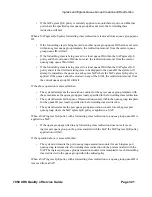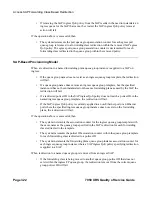
Ingress and Egress Queue Group Creation and Redirection
7950 XRS Quality of Service Guide
Page 309
Pseudowire Shaping for Layer 2 and Layer 3 Services
This feature allows the user to perform ingress and egress data path shaping of packets forwarded
within a spoke-sdp (PW). It applies to a VLL service, a VPLS/B-VPLS service, and an IES/VPRN
spoke-interface.
The ingress PW rate-limiting feature uses a policer in the queue-group provisioning model. This
model allows the mapping of one or more PWs to the same instance of policers that are defined in
a queue-group template.
Operationally, the provisioning model in the case of the ingress PW shaping feature consists of the
following steps:
1. Create an ingress queue-group template and configure policers for each FC that needs to
be redirected and optionally for each traffic type (unicast, broadcast, unknown, or
multicast).
2. Apply the queue-group template to the network ingress forwarding plane where there
exists a network IP interface that the PW packets can be received on. This creates one
instance of the template on the ingress of the FP. One or more instances of the same
template can be created.
3. Configure FC-to-policer mappings together with the policer redirect to a queue-group in
the ingress context of a network QoS policy. No queue-group name is specified in this
step, which means the same network QoS policy can redirect different PWs to different
queue-group templates.
4. Apply this network QoS policy to the ingress context of a spoke-sdp inside a service, or
to the ingress context of a PW template and specify the redirect queue-group name.
One or more spoke-sdps can have their FCs redirected to use policers in the same policer queue-
group instance.
The egress PW shaping provisioning model allows the mapping of one or more PWs to the same
instance of queues, or policers and queues, that are defined in the queue-group template.
Operationally, the provisioning model consists of the following steps:
1. Create an egress queue-group template and configure queues only, or policers and queues
for each FC which needs to be redirected.
2. Apply the queue-group template to the network egress context of all ports where there
exists a network IP interface which the PW packets can be forwarded on. This creates one
instance of the template on the egress of the port. One or more instances of the same
template can be created.
Summary of Contents for 7950
Page 12: ...Page 12 7950 XRS Quality of Service Guide List of Figures ...
Page 16: ...Preface Page 16 7950 XRS Quality of Service Guide ...
Page 82: ...Editing QoS Policies Page 82 7950 XRS Quality of Service Guide ...
Page 90: ...Applying Network Queue Policies Page 90 7950 XRS Quality of Service Guide ...
Page 96: ...Editing QoS Policies Page 96 7950 XRS Quality of Service Guide ...
Page 98: ...Command Hierarchies Page 98 7950 XRS Quality of Service Guide ...
Page 108: ...Command Hierarchies Page 108 7950 XRS Quality of Service Guide ...
Page 156: ...Basic Configurations Page 156 7950 XRS Quality of Service Guide exit exit ...
Page 164: ...Queue Depth Monitoring Page 164 7950 XRS Quality of Service Guide ...
Page 304: ...Service Queue QoS Policy Commands Page 304 7950 XRS Quality of Service Guide ...
Page 368: ...Command Hierarchies Page 368 7950 XRS Quality of Service Guide ...
Page 430: ...Configuration Commands Page 430 7950 XRS Quality of Service Guide ...
Page 532: ...Editing QoS Policies Page 532 7950 XRS Quality of Service Guide ...
Page 552: ...Editing Advanced Policies Page 552 7950 XRS Quality of Service Guide ...
Page 600: ...Command Hierarchies Page 600 7950 XRS Quality of Service Guide ...
Page 602: ...QoS Commands Page 602 7950 XRS Quality of Service Guide ...
Page 610: ...Standards and Protocols Page 610 7950 XRS Quality of Service Guide ...
Page 612: ... 2015 Alcatel Lucent All rights reserved 3HE 09868 AAAA TQZZA 01 ...





















